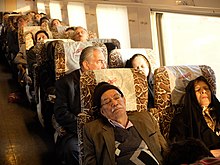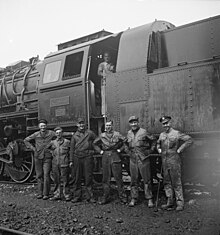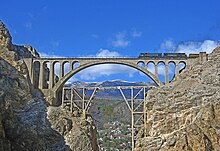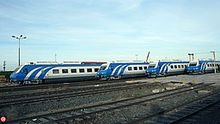Rail transport in Iran
The rail traffic in Iran is mainly from the Islamic Republic of Iran Railways ( RAI ; persian شركت راه آهن جمهوری اسلامی ایران sherkat-e rah ahan dschomhuri-ye eslami-ye Iran or generalراه آهن ایران Rah Ahan-e Iran ). In addition, there are private rail transport companies and local companies thatoffer public transport by rail.
The railways in Iran are part of the European standard gauge network and apply its standards.
history
Political blockade
In the 19th century, the Russian Empire and Great Britain competed for supremacy in Central Asia ( The Great Game ). The Iran (then: "Persia") was in a conflict of interest between the Russian Empire , the access from the north Persian Gulf was looking for and the UK , which in the interest of its colony of British India wanted to prevent, and in turn from the east a rail link tried to establish to the Mediterranean. All railway projects in Iran at that time are to be seen under this conflict of interest. There had been plans to build railways in Iran since the end of the 19th century, but their implementation failed due to mutual blockades by the great powers. The dispute between the two powers culminated in a treaty in which the Iranian government promised to refrain from building the railway for some time.
The first plans for the construction of a railway in Iran date from the reign of Nasser-Din Shah , when Paul Julius Reuter received a general concession for the industrialization of Iran. In 1873 the concession given to Reuter to build a railway in Iran was canceled at the instigation of Russia (at that time, Tsar Alexander II was ruling ).
In 1882 a French businessman was granted the concession to build a railway from Rasht to Tehran . But he lacked the necessary capital; the work was stopped shortly after the start.
A Belgian company also took over the concession for the construction of a line between Tehran and Rey from the French . A narrow-gauge railway was built for 2 million Belgian francs and passenger cars were transported to Iran. This first 8.7 km long Persian railway was inaugurated in 1888 as a meter-gauge horse - drawn railway , later switched to steam operation and shut down in 1962 .
First long distances
As part of the British-Russian invasion of Iran in World War I , the Russian military built the 146 km long railway line Tabriz – Jolfa in Russian broad gauge from 1914 to 1916 . This was the country's first long-distance route. In 1921 the railway facilities, as far as they were on Iranian territory, were handed over from the Soviet Union to the Iranian state. The 53 km long branch from Sufian on the main line to Sharaf Chanech on the shores of Lake Urmia was the starting point for the Van – Tabriz railway in the 1970s .
Trans-Iranian Railway

The first major inner-Iranian rail project was the Trans-Iranian Railroad . After Russia failed as a great power due to the October Revolution , rail projects in Iran no longer posed a threat to Great Britain. In addition, there were US interests in developing the country better with its oil reserves. Since the late 1920s, under Reza Shah, the Trans-Iranian Railway was built as a north-south route between the Persian Gulf and the Caspian Sea and started operating in 1938. The topography, which is extremely difficult in parts, required around 3,000 bridges and numerous tunnels, 120 of them in the Zāgros Mountains alone . In this context, the Iranian State Railways was founded in 1929.
In 1941, during World War II , the Anglo-Soviet invasion of Iran took place . The railroad operation was taken over by US-American (3473 soldiers) and Soviet troops and operated as the " Persian Corridor ". On it were important war American goods transported to the Soviet Union. American diesel locomotives of the ALCO RSD-1 series were also used.
expansion
After the Second World War in 1946, Iran took over the northwest of the country by the Red Army built broad gauge network in the following years on standard gauge umgespurt was. The country's rail network was expanded under Mohammad Reza Shah . After 1979, the expansion of the route slowed down initially due to the Islamic Revolution and the First Gulf War . Since the beginning of the 1990s, the expansion of the network has been pushed forward again.
In 1975 the Tabriz – Jolfa line was electrified as the first line in Iran . Because oil is available cheaply, there is no economic incentive for this; the rest of the Iranian Railways network is still operated today with diesel locomotives and diesel multiple units.
Projects
The route network is to be expanded to 25,000 km by 2025.
There is a project to electrify the northern section of the Trans-Iranian Railway in cooperation with Russia between the border with Turkmenistan and Garmsar (495 km). There is also a corresponding project for the 926 km long Tehran – Mashhad connection (the northern section of the Trans-Iranian Railway in Garmsar and the Garmsar – Mashhad railway line ) in cooperation with China.
The projects all suffer from the economic sanctions that exist against Iran.
Technical parameters
Due to the very mountainous topography in the interior of the country - the routes rise from sea level to around 2500 m - engineering structures are often required on a large scale for railway construction .
Most of the network was built in standard gauge . In the area close to the border with the northern neighbors, there are short routes in Russian broad gauge to connect to their networks . The lane change systems for vehicles to cross over to the broad gauge are located in the Iranian border stations. The entire Zahedan – Quetta line to Pakistan has a gauge of 1676 mm. In Zahedan, the broad gauge trains from the direction of Pakistan and those from the west each enter their own station. There is no lane change system , goods have to be reloaded.
The electrified sections of the Iranian railway network were equipped with technology for 25 kV / 50 Hz .
In 2014, automatic train protection with the ATP safety system was put into operation between Tehran and Mashhad (925 km) . This is the first line in the Iranian railway network to be equipped with automatic train protection. More than 10,000 km are to follow. 50 diesel railcars , 30 diesel locomotives of the EuroRunner 24 PC series (also: IranRunner ) from Siemens and Mapna Locomotive Engineering and Manufacturing Company as well as 10 further Paradis InterCity diesel railcars will be equipped for the use of train protection.
Also in 2014 the RAI had 645 locomotives and 2076 passenger cars .
organization
The railway infrastructure is operated as a state railway by the Railway Company of the Islamic Republic of Iran (IRIR or RAI).
The company is under the supervision of the Ministry of Roads and Transport. Insofar as IRIR operates as a railway company , this traffic is carried out by two separate subsidiaries:
- The Raja Rail Transportation drives since 1996 passenger trains
- The Railway Transportation Company operates the freight transport .
In addition, there are a number of other companies in Iran - mostly organized under private law and not belonging to IRIR - that offer rail transport services.
Route network
In 2019, the route network was 13,000 km long. Of this, 1,559 km were double-tracked in 2014 , 19 km were three-tracked. 9500 km of route were under construction or planning. The network is to be expanded to 25,000 km by 2025. Despite this ambitious investment program, there is still an investment backlog in infrastructure and general transport policy in Iran has given road transport priority over rail. The transport capacity of the railway is 1.5 million tons , while the road has a capacity of 10.5 million tons.
Central points in the Iranian railway network are Tehran and Qom , where several lines meet.
Lines in operation
- Badrud – Shiraz railway line
- North-South Railway (Turkmen border - ( Mashhad ) - Bandar Abbas )
- Tehran – Hamadan railway line
- Railway line (Tehran–) Garmsar – Mashhad
- Qom – Zahedan railway line
- Tehran – Tabriz railway line
- Tabriz – Jolfa railway line ( Nakhichevan Autonomous Republic )
- Torbat-e Heidarije – Herat railway line , Afghan section still under construction
- Transiran Railway ( Abadan - Tehran - Gorgan )
- Van – Tabriz railway line (Turkey)
- Zahedan – Quetta railway line (Pakistan)
New lines in operation in sections
- Arak – Chosrawi railway line , approx. 450 km, single-track.
- Maragha – Urmia railway line , which was put into operation between Maragha and Mahabad in 2015. The remaining 97 km long section to Urmia is to be opened in 2017 [obsolete] . It is single-track, is 184 km long and can be driven at 160 km / h.
- Tehran – Isfahan railway line , high-speed line , 424 km for 300 km / h, sections still under construction
Routes planned or under construction
- Qom – Arak high-speed line
- Qazvin – Astara (–Azerbaijan) railway line
- The railway connection Mashhad – Tschabahar, a total of 1350 km, that is:
- Zahedan – Tschahbahar railway line , 550 km, single track, under construction, and
- Zahedan – Mashhad railway line , in planning
- Railway line Shiraz – Asaluyeh via Bushehr , 647 km
- Sari – Rasht railway line
- Dorud – Borudscherd railway line
- Mianeh – Ardebil railway line , 175 km, single track, 160 km / h, expected completion in 2019 [obsolete]
- Bushehr – Asaluyeh railway line , 207 km, single-track
- Railway line (Shiraz–) Eghlid – Yazd , 247 km, single track, 9 intermediate stations
- Gorgan – Mashhad railway line , 190 km, single-track
- Schiras – Bandar Abbas railway line , 354 km, single-track, planned
- Hamedan – Jokar railway line , 75 km
Border crossing points
- in Turkey to the Türkiye Cumhuriyeti Devlet Demiryolları (TCDD),
- to the Nakhichevan Autonomous Republic ( lane change ) from Azerbaijan and earlier to Armenia (interrupted due to the hostility between Armenia and Azerbaijan),
- to Turkmenistan (lane change) and
- to Pakistan (change of lane); however, the state of development on the Pakistani side is so outdated that Iran proposed a completely new line there.
Projects in cross-border traffic
Two international railway corridors of the OSJD , No. 6 in east-west direction ( People's Republic of China - Mediterranean ) and No. 11 in north-south direction (Northern Europe / St. Petersburg - Indian Ocean / Persian Gulf ), cross Iran and are supposed to be built or expanded.
- to Azerbaijan (lane change, to Baku ), under construction
- The Chaf – Herat railway line (Afghanistan) is under construction .
- Since 2000 there has been an agreement with Iraq to (re) establish the cross-border rail link, a project that has not yet been completed due to the political situation in Iraq. This includes the projects
- Kermanshah – Khosravi (–Bagdad) railway line via Mosul , single-track, 536 km. The construction should be completed in 2016, but this did not come about due to the political situation in Iraq.
- Shalamcheh-Basra railway line . The first section has a length of 51 km, of which 16 km on Iranian territory (completed) and 35 km in Iraq. The line should go into operation in 2015.
- With Bazargan a second border station for traffic with Turkey is to be built.
- A railway line between Armenia and Iran is being considered, but has not yet been implemented.
traffic
Between 2013 and 2017, the share of rail in the transport volume rose from 4.4% to 12.8%.
passenger traffic

In 2011, the Iranian railways carried 29 million travelers with 21 billion passenger kilometers . This corresponds to a share of 11% of the total traffic volume in the country. The long-distance connections are usually operated by private providers.
The Iranian railways repeatedly purchase used vehicles from Europe, including Germany.
During the 2020 COVID-19 pandemic , RAI took extensive measures to maintain operations - with a reduced timetable.
Freight transport
Two overseas ports in the country, Bandar Abbas and Mahschahr are connected to the railway network. Internationally, the Iranian railway sees itself as a hub of rail traffic between the Commonwealth of Independent States (CIS), China, India and Europe. The railway expects a lot from the support of long-distance freight trains in connections between these traffic source and destination areas.
22,000 wagons were available to traffic in 2013, compared with 24,000 in 2017. In 2007 the railway was partially privatized, the rail freight traffic as a whole, so that the cars now run under private management.
In 2011, the Iranian railways carried 33 million tons of goods at 22 billion tonne kilometers . In 2017, the transport volume was 40 million t. Mainly cotton , fertilizers , sulfur , food and industrial goods are transported by rail. The fact that the share of rail in freight traffic is not higher is also due to the fact that the railways (yet) have no access to the source areas of some bulk goods . 40% of the freight volume in Iran consists of mazut , which is extracted in northern Iraq and taken by road tanker trucks to the Iranian sea ports for further processing . There is also an investment backlog in vehicles. In order to increase the share of the freight transport market, despite the relatively high rate of inflation, the tariffs for freight transport have not been increased for eight years and considerable discounts are granted for the transport of certain types of bulk goods .
Rail-bound public transport
In recent years, rail-bound transportation systems have been set up in various major cities in Iran.
Subways
Light rail vehicles
literature
- Gholamreza Najafi and Yousefali Malekan: Railway often the Islamic Republic of Iran: a New Perspective . In: OSJD Bulletin 1–2 (2017), pp. 15–20.
- tf: Iran. There is a lot of catching up to do . In: Privatbahn 2019, pp. 88–89.
Web links
- Official website of the Iranian Railway (Persian)
- Raja website (English)
- Unofficial website with timetables, maps, pictures, information (English)
- Download the current timetable (Persian)
- RAI advertising film - also with historical recordings Video on YouTube
Remarks
- ↑ Passenger trains to Istanbul and Damascus ( Syria ) ran in international traffic until the political situation deteriorated .
- ↑ tf: Iran , p. 89, gives completely different figures: 2.9 million passengers in 2013 and 4.9 million passengers in 2017 for local rail transport .
Individual evidence
- ^ A b c Neil Robinson: World Rail Atlas . The Middle East and Caucasus. tape 8 , 2006, ISBN 954-12-0128-8 , pp. 18-19 .
- ↑ Don Denevi, B. Hall: United States Military Railway Service . Toronto 1992. ISBN 1-55046-021-8 , pp. 8, 73-77.
- ↑ Jerry A. Pinkepank: The Second Diesel Spotter's Guide . Kalmbach Books 1973, p. 233.
- ^ Network expansion is in full swing , Railway Gazette , December 24, 2008.
- ↑ a b tf: Iran , p. 88.
- ^ H. Petrovitsch: Route electrification in Iran . In: Eisenbahn-Revue International 8–9 / 2017, p. 393f.
- ^ Electrification Tehran – Mashhad . In: HaRakevet 108 (March 2015), p. 26.
- ↑ a b Hossein Ashouri: The Middle East as a strategic bridge for the east - west and north - south corridors . In: Journal of the OSJD 4/5 (2014), pp. 13-16 (13).
- ^ Homepage of Raja Rail Transportation .
- ^ The unofficial homepage of Iranian railways .
- ↑ a b c d tf: Iran , p. 89.
- ↑ a b c d Najafi & Malekan, p. 17f.
- ↑ a b c d e f Bernd Seiler: The Iranian State Railway . In: Fern-Express 3/2016, pp. 14–21.
- ↑ a b c d e Najafi & Malekan, p. 18.
- ↑ Kieslich, Wolfgang: Teheran - Hamadân inaugurated . In: Fern-Express 2/2017 (No. 134). ISSN 0933-7598 , pp. 49f (50).
- ↑ a b c d e f g HaRakevet 95 (December 2011), 95:08 Other Middle East Railways, C. Iran, (iii) Massive Expansion Plans , p. 16.
- ^ NN: FS Group signs Iranian agreements . In: HaRakevet 118 (September 2017). ISSN 0964-8763 , p. 16.
- ↑ HaRakevet 95 (December 2011), 95:08 Other Middle East Railways, C. Iran, (ii) New Line in the East , p. 16; Abbas Nazari: Port of Chabahar: South-East Gate of Iran's International Routes . In: OSJD Bulletin 1/2018, pp. 6-9 (7).
- ↑ Report of the Miana News Agency (Persian)
- ↑ Website about the project (Persian).
- ↑ Internet site ( Memento of July 11, 2014 in the Internet Archive ), June 3, 2012 (Persian)
- ↑ a b c Hossein Ashouri: The Middle East as a strategic bridge for the east - west and north - south corridors . In: Journal of the OSJD 4/5 (2014), pp. 13-16 (14).
- ^ Hossein Ashouri: The Middle East as a strategic bridge for the east - west and north - south corridors . In: Journal of the OSJD 4/5 (2014), pp. 13–16 (13f).
- ↑ Golnar Motevalli: Iranian engineer brings roads, rail to Afghan west . In: Reuters , April 17, 2010.
- ↑ Map ( Memento of the original from August 17, 2014 in the Internet Archive ) Info: The archive link was inserted automatically and has not yet been checked. Please check the original and archive link according to the instructions and then remove this notice. (Persian).
- ↑ HaRakevet 95 (December 2011), 95:08 Other Middle East Railways, C. Iran, (v) Armenia Plans Direct Link with Iran , p. 17.
- ^ Trains . On: Unofficial website about the Iranian railways .
- ↑ pwald: Again DB cars in Iran . In: Eisenbahn-Revue International 4/2015, p. 160
- ↑ HaRakevet 107 (December 2014), p. 20, F. Iran, (ii)
- ↑ HaRakevet 105 (June 2014), A: Iran, (ii): More German Second-Hand Coaches , p. 16
- ↑ HaRakevet 89 (June 2010), 89:08 Other Middle East Railways, C. Iran, (ii) Acquisition of Former Deutsche Bundesbahn Coaches , p. 17.
- ^ RAI: Experience of RAI to confront and control Covid-19 . In: OSJD Bulletin 2/2020, pp. 40f.
- ^ Najafi & Malekan.
- ↑ Najafi & Malekan, pp. 18f.
- ^ Najafi & Malekan, p. 17.






